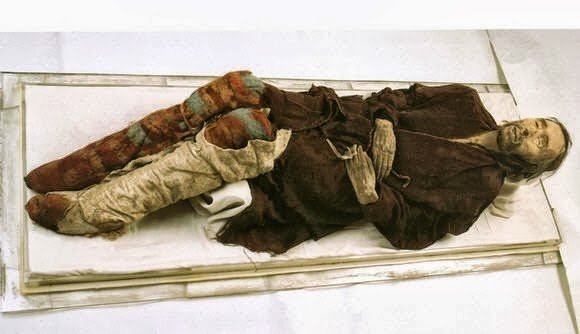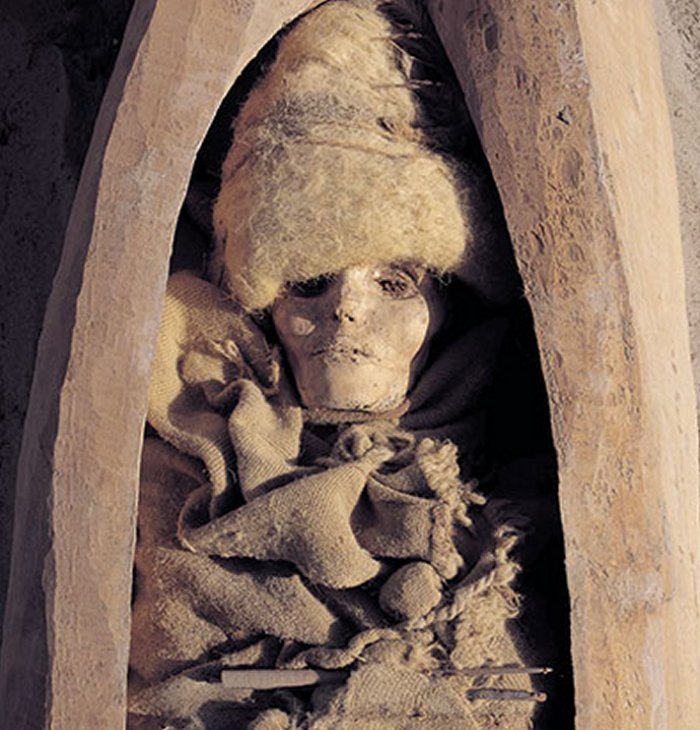Ellen Lloyd – AncientPages.com – The Sleeping Beauty of Loulan is an extraordinary 3,800-year-old mummy that until today is still preserved. It is one of 200 mummies found in the Takla Makan Desert of the Tarim Basin, China.
The Takla Makan desert remains a place shrouded in mystery. Ancient people believed that once you entered this place there was no way out.


The Beauty of Xiaohe (ca. 1800–1500 BCE) is extremely well preserved. Her body was found wrapped in a wide woolen cloak. Courtesy of the Cultural Relics Bureau of Xinjiang and Wang Da-Gang. source
A very long time ago, there were houses and temples here. Today, everything is buried under the sand.
Precious ancient relics are hidden deep under the “Sea of Death”, or the Takla Makan desert.
Archaeologists are beginning to discover some of the secrets that have been hidden in this mysterious region. Still, it seems that we are only scratching the surface and only time will tell what more wonders are waiting to be unraveled.
The Sleeping Beauty of Loulan was discovered in 1980 when a film was being made about the Silk Road. A closer examination of the region led to the discovery of 200 mummies that were buried in relatively shallow graves, and with no elaborate embalming rituals. What was remarkable about the mummies was the fact that they were in much better condition than the Egyptian mummies in the Valley of the Kings.
The Loulan mummy is of Caucasian origin. She has high cheekbones, high bridged nose, and blonde hair.
by TaboolaSponsored LinksYou May LikeIf you own a mouse, you have to play this game. No Install. Play for free.PanzerRushSanya boosts efforts to attract overseas tourists to its tropical shoresSCMP for Sanya Tourism BoardCouple Made a Bet, See How They Look After A YearHouse JoggerThe boy meets a dog on the street – no one expected what happened next.Women’s MethodThese Are The Most Beautiful

She died sometime in her 40s and is still dressed in her red robes, her hair crisply braided in what was probably a very fashionable 3800 years ago. It is believed that she died from the hard life she lived, traveling the Silk Road to an unknown destination, breathing in a toxic mix of dust, sand, and smoke from open fires that eventually destroyed her lungs.
She was buried alongside another mummy known as the Cherchen Man, a six-foot redhead whose DNA has revealed he was a Celt. How these two came to be buried by the Silk Road, along with two other women and a baby and surrounded by hundreds of other mummies of European origin found in the same area, is a tantalizing mystery.
Who was she, and why did she die so far from her ancestral homeland? It is not possible to tell, but the company with which she lay was a very mixed one.
Among them were warriors, kings, farmers and artisans, all taking their last rest at least a 1000 years before Caucasians were believed to have ventured this far into Asia. The Uyghur people, who themselves look more European than Asian immediately claimed the Loulan Beauty as their ancestor, and insist that this is proof they inhabited the region before the Chinese. This proved a sticking point in the study of these mummies since the Chinese discouraged foreign scientists from investigating the remains.
However, in 1993, Professor Victor H. Mair of the University of Pennsylvania, and Italian geneticist Paolo Francalacci obtained and were able to study samples of the remains. From these samples, the pair was able to confirm that the mummies were European in origin, and not related to the Uyghur.
They possibly crossed into China from Siberia, into an area that once was green and hospitable, where people from many cultures came together, from Han Chinese to Northern Celts.
The oldest corpse is an old man who died 1500 years ago, the youngest a tiny baby in a bonnet, with blue stones covering its eyes. With their European origins, there were very likely many blue-eyed people among travelers.
The implications of this discovery are far-reaching. Clearly the ancient world of 3000-4000 years ago was more of a melting pot than has previously been believed, and cultures from Northern Europe and Asia were well known to each other.
A mummy called the Cherchen Man was found next to the Sleeping Beauty of Loulan. Xinjiang Regional Museum, Urumqi, China
It paints a picture of a more cosmopolitan ancient world and makes it easier to understand why some myths, stories, and art are common to so many cultures. For example, the ‘endless knot’ of the Celts is a familiar motif in Chinese art as well.
Did the red-haired warrior and the Sleeping Beauty of Loulan help to bring them into Asia – or did others of their culture take them back instead?
Only the Beauty of Loulan knows for sure, and she took her secret with her to the grave.
Today the Loulan Beauty lies in a glass case in the Xinjiang Uyghur Autonomous Region Museum, specially climatized to prevent any deterioration.
Just like the blinking mummy, the Loulan mummy is still amazingly preserved and remains a beauty long after death.





